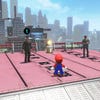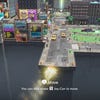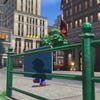Super Mario Odyssey: Switch's next big technical showcase?
Digital Foundry goes hands-on with the E3 demo.
Despite initial pre-launch concerns, Nintendo's Switch enjoyed a great debut and its software line-up has managed to impress from day one. We've enjoyed one of the best Zelda games ever, swiftly followed up by an excellent port of Mario Kart 8, bolstered further by the impressive Arms - and that just covers the first party offerings. There's more to come before year's end, but Super Mario Odyssey looks set to cap off 2017 very nicely.
Digital Foundry had the opportunity to spend 20 minutes with the game during the event, capturing action across two very different levels, giving us an insight into the title's technical make-up. It's fascinating to see how the development team is already pushing the Switch hardware, and although there are some compromises and limitations, we should keep in mind that this is still very much a work-in-progress - and we're hopeful that some of the minor issues we noted in this demo will be resolved for the final game.
The first level we played was New Donk City, a section of cityscape floating in the sky. Platforms take you outside of the main city block, and doors warp you to other areas. In this section, we got to grips with the curious control system - using motion controls, you flick the joycons to fling your hat, or spin your hands around for a circular attack. Other motion inputs modify the way the hat is thrown. Initially, it's a little complex, but standard button controls work too: here it's more about how you move the stick and hold the buttons - quickly rotate the stick and hit it, and you access the same circular attack, for instance.
On a technical level, what's interesting about this first environment is that we finally see Nintendo tackling a bustling city environment, delivered at the firm's signature 60fps. Achieving this level of performance doesn't come for free, so there are compromises in play. For one thing, drawing many 3D character models would be a huge drain on resources, so to get around this while still conveying a busy environment, distant NPCs appear to be rendered as 2D objects. As you get closer to them, they fade out, replaced with 3D models. This can look a little strange, since the 3D replacements aren't always lined up with outgoing sprites.
Beyond that, the actual 3D models in the scene are often animated at half-rate, so while the game runs at 60fps, some of these characters are displayed at 30fps. It's an old trick used in many titles - most recently, Halo 5 - but less distracting here, since you're generally not interacting with them in any meaningful way. These aren't really complaints as much as observations, and give some insight into what it takes for this title to reach the all-important 60fps on Switch hardware.
Buildings around you are generally quite detailed, as is the texture work. It's very much unlike anything we've seen in Mario before but it fits with the series aesthetic. The level looks good overall, but has a few rough edges - not least in terms of performance, where there are a few drops in the otherwise buttery-smooth 60fps frame-rate. Most of the minor hitches seem to kick in during traversal, not from any obvious increase to GPU load, but more likely through CPU bottlenecks on data streaming.
New Donk City is a lovely way to kick off proceedings, but it's the second stage - a frozen desert of sorts - that really highlights how beautiful art and level design combine with superb technical direction. There's the sense here that much of the philosophy behind the tech is taken from Super Mario 3D World on Wii U, as there are definite similarities here - for one thing, the scale of the environment is much larger, stretching out into the distance. There are also some glorious ideas here, like 2D sections wrapped around 3D towers, for example.
What's impressive here is the attention to detail in the lighting. Obviously, there's nothing like real-time global illumination happening here, but Nintendo takes on board the key idea and replicates it with its own technology - so the walls take on a red hue based on light bouncing off the red sand. Texture work is rich and detailed throughout and world geometry is ample. This is clearly a huge step up from Mario's previous adventures just in terms of sense of scale, and it's great to see that performance here is almost totally rock-solid - no mean feat, bearing in mind that this it the first non-linear 'exploratory' Mario title to target 60fps (predecessors like Super Mario 64 and Super Mario Sunshine opted for 30Hz gameplay instead).
Right now, the elephant in the room is resolution - Super Mario Odyssey is currently locked at 720p resolution, and it's by far the biggest issue with the game's presentation. Not only that, but the E3 demo was running docked, which leaves us wondering whether this is work-in-progress code built around mobile mode, with docked enhancements (preferably a resolution bump to 720p or 1080p) coming later. Alternatively, perhaps we are looking at the full-fat experience right here, with Nintendo planning to nip and tuck at the game for the purposes of the mobile configuration. Only time will tell.
Ultimately though, the game is shaping up very well indeed. Aiming for 60fps gameplay in a title like this is an ambitious goal and as a game, Mario is shaping up to be something special. First impressions are that it's a little strange, but it grows on you and it genuinely feels like Nintendo is trying to find ways to revamp the series by breaking free of traditions. Yes, it shares many elements with 3D Mario games of the past, but it does feel unique. In this respect, it's very much in line with the philosophy behind The Legend of Zelda: Breath of the Wild - and that turned up rather nicely.


















